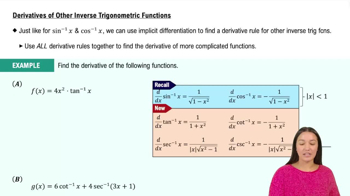Textbook Question
If f is a one-to-one function with f(3)=8 and f′(3)=7, find the equation of the line tangent to y=f^−1(x) at x=8.
 Verified step by step guidance
Verified step by step guidance Verified video answer for a similar problem:
Verified video answer for a similar problem:



 7:26m
7:26mMaster Derivatives of Inverse Sine & Inverse Cosine with a bite sized video explanation from Patrick
Start learning